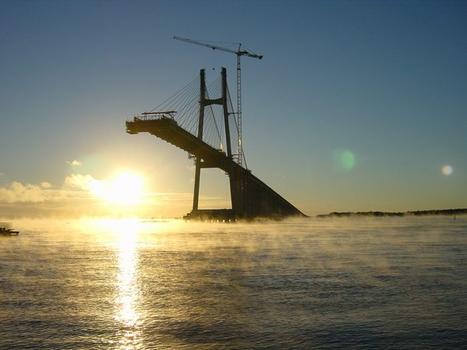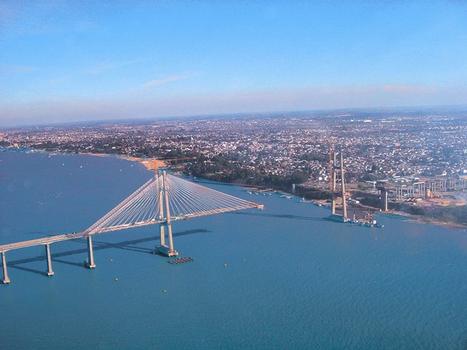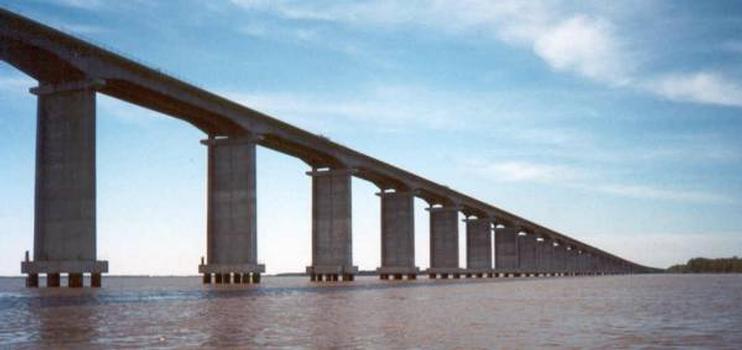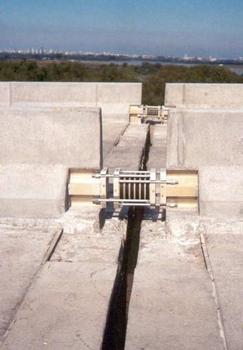General Information
| Other name(s): | Puente Rosario-Victoria |
|---|---|
| Beginning of works: | 1998 |
| Completion: | 22 May 2003 |
| Status: | in use |
Project Type
| Structure: |
Cable-stayed bridge with semi-fan system |
|---|---|
| Function / usage: |
Road bridge |
| Structure: |
Three-span cable-stayed bridge |
| Secondary structure(s): |
Structurae Plus/Pro - Subscribe Now! Structurae Plus/Pro - Subscribe Now! |
Location
| Location: |
Rosario, Santa Fe, Argentina Victoria, Entre Ríos, Argentina |
|---|---|
| Crosses: |
|
| Part of: | |
| Coordinates: | 32° 52' 10.70" S 60° 40' 59.97" W |
Technical Information
Dimensions
| main span | 330 m | |
| total length | 4 098 m | |
| deck | deck width | 16 m |
| main bridge | ||
|---|---|---|
| length | 608 m | |
Excerpt from Wikipedia
Rosario-Victoria Bridge (in Spanish, Puente Rosario-Victoria) is the informal name of the physical connection between the Argentine cities of Rosario (province of Santa Fe) and Victoria (province of Entre Ríos).
This road link is composed of several bridges, viaducts, and earth-filled sections. It crosses the main course of the Paraná River and touches down on several islands of the Paraná Delta in the way.
Works on the project began in 1998, but they were repeatedly interrupted due to lack of continued funding from the national and the provincial state, especially in the worst part of the Argentine economic crisis of 2001. Public transit access to the bridge was opened on May 20, 2003.
The link between the two cities spans a total of 59.4 kilometers (37 mi). The total length of the various bridges and their viaducts is 12.2 km (7.5 mi). The main bridge is 4,098 meters (13,440 ft) long, with central cable-stayed span of 350 meters (1,148 ft). Among the materials used were about 250,000 cubic meters (326,987 yd³) of concrete, 63,000 tons of ADN-420 type steel, and 17,618 tons of asphalt. The access to the main bridge on the western side is in the northern border of Rosario, on the limit with the city of Granadero Baigorria. The official name of the main bridge (cable-stayed) is Nuestra Señora del Rosario (Our Lady of Rosario).
The project was executed by a private company (Puentes del Litoral S. A.), which was granted subsidies from the national state and the provincial states of Santa Fe and Entre Ríos, totalling about $385 million . The company received the operation and maintenance concession of the bridge for 25 years.
Until the opening of this bridge, the only road link between the two provinces, and between two commercially very important regions of Argentina, was the Hernandarias Subfluvial Tunnel which joins the cities of Santa Fe and Paraná, about 120 kilometers (75 mi) north from Rosario. The southern Paraná is crossed by another cable-stayed bridge, the Zárate-Brazo Largo Bridge, joining Entre Ríos and Buenos Aires province.
Text imported from Wikipedia article "Rosario-Victoria Bridge" and modified on July 22, 2019 according to the CC-BY-SA 4.0 International license.
Participants
Relevant Web Sites
Relevant Publications
- À travers le Paranà avec des systèmes DYWIDAG. Pont haubané entre Rosario et Victoria, Argentine. In: DSI Info, n. 10 ( 2001- 2002), pp. 36.
- (2003): Bridge Protection of the Rosario-Victoria Bridge, Argentina. In: Structural Engineering International, v. 13, n. 4 (November 2003), pp. 227-231.
- (2002): Buffers longitudinali, dettagli costruttivi e funzionamento. In: Le Strade, n. 6 ( 2002).
- DYNA Grip Schrägseilsysteme für Brückenbau über den Paranà, Argentinien. Fertigstellung des Einbaus von 128 Stück DYNA Grip-Schrägseilen bei Großbrückenprojekt in Argentinien. In: DSI Info, n. 11 ( 2002- 2003), pp. 49.
- DYNA Grip Stay Cable System for construction of a bridge over the Paraná river, Argentina. Installation of 128 DYNA Grip Stay Cables for large-scale bridge project in Argentina completed. In: DSI Info, n. 11 ( 2002- 2003), pp. 49.
- About this
data sheet - Structure-ID
20001351 - Published on:
11/03/2001 - Last updated on:
13/01/2018










